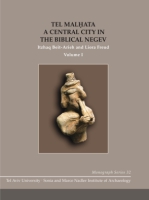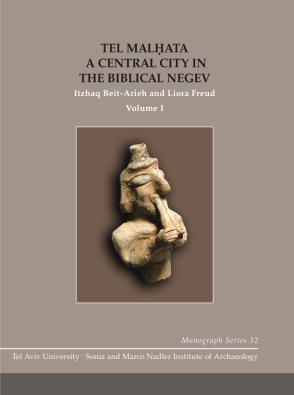Tel Malḥata
A Central City in the Biblical Negev
By Itzhaq Beit-Arieh and Liora Freud
“The volume covers the site’s history, archaeology, architecture, finds, and inscriptions. Also included are analyses of its ancient faunal and floral assemblages that inform our understanding of the site’s historical environment and how past populations interacted with the natural world. The work is conveniently supplemented with maps, plans, photos, drawings, and charts.”
- Offers
- Description
- Reviews
- Table of Contents
Customers in Israel buy here.
Tel Malḥata is an elliptical-shaped mound located in the eastern sector of the Arad–Beer-sheba Valley and spreads across some 18 dunams. Tel Malḥata is generally identified with biblical Moladah, one of the cities of Judah, although other identifications have been suggested. The Arabic name of the site, Tell el-Milḥ (“Hill of the Salt”), is apparently indicative of its association with the production and distribution of salt from the Dead Sea in more recent times. The many Bedouin graves on the upper terrace of the tell significantly hindered the planning of the excavations, and consequently the excavations were concentrated mainly where no graves were discerned. The two-volume report consists of 22 chapters that take the reader through six strata of civilization, ranging from the Middle Bronze Age to the early Byzantine period.
“The volume covers the site’s history, archaeology, architecture, finds, and inscriptions. Also included are analyses of its ancient faunal and floral assemblages that inform our understanding of the site’s historical environment and how past populations interacted with the natural world. The work is conveniently supplemented with maps, plans, photos, drawings, and charts.”
Volume 1
Section One: History and Background
Chapter 1. General Introduction Itzhaq Beit-Arieh and Oren Tal
Section Two: Stratigraphy and Architecture
Chapter 2. The Excavation Itzhaq Beit-Arieh and Liora Freud
Section Three: The Finds from the Middle Bronze Age
Chapter 3. The Middle Bronze Age Pottery Gilad B. Jaffe
Section Four: The Finds from the Iron Age
Chapter 4. The Pottery of Strata V–III Liora Freud et al.
Volume 2
Chapter 5. Inscriptions Itzhaq Beit-Arieh et al.
Chapter 6. Iron Age Stamp Seals, a Cylinder Seal and Impressions Irit Ziffer
Chapter 7. An Egyptian and a Phoenician Scarab Nir Lalkin
Chapter 8. Scale Weights Raz Kletter
Chapter 9. Iron Age Figurines Raz Kletter
Chapter 10. A Phallus-Shaped Clay Object Itzhaq Beit-Arieh
Chapter 11. Remains of Wooden Furniture from Area H Itzhaq Beit-Arieh
Chapter 12. Stone Artifacts from the Iron Age Liora Freud and Nadin Reshef
Chapter 13. Metal Artifacts from the Iron Age Nadin Reshef
Chapter 14. Small Finds from the Iron Age Liora Freud and Nadin Reshef
Section Five: The Finds from the Hellenistic, Roman and Byzantine Periods
Chapter 15. Hellenistic, Roman and Byzantine Pottery Oren Tal
Chapter 16. Hellenistic, Roman and Byzantine Coins Arieh Kindler
Chapter 17. Glass Vessels Ruth E. Jackson-Tal
Chapter 18. Hellenistic, Roman and Byzantine Small Finds Oren Tal et al.
Section Six: Interdisciplinary Studies
Chapter 19. Archaeobotanical Remains Nili Liphschitz
Chapter 20. Archaeozoological Remains Moshe Sade
Chapter 21. Shells Henk K. Mienis
Section Seven: Summary
Chapter 22. Tel Malḥata:
From the Middle Bronze Age to the Byzantine Period Itzhaq Beit-Arieh, Liora Freud, and Oren Tal
Mailing List
Subscribe to our mailing list and be notified about new titles, journals and catalogs.




